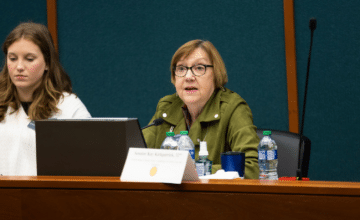For reunification of families to be truly successful, child welfare agencies and communities must recognize and address the critical underlying needs of parents.
This is excerpted from a three-part blog series exploring the mental health needs of very young children. Click here for the full article originally published in the Huffington Post.
“Ten years ago, after my baby was taken from me, there was no team of people to ensure a common goal of safety and reunification. What I needed more than anything was help, support and even just a kind word.”
For many parents in the unfortunate and heart-breaking position of having their child placed in the hands of the state, this Iowa mother captures the essence of what they need to have a meaningful opportunity to reunify with their baby: a team behind them. These parents come with complex challenges such as substance abuse, domestic violence, economic insecurity, mental health concerns, and trauma. They need help from multiple agencies to navigate their journey to health and successful parenting. If those issues are not acknowledged and treated, the chances for success are greatly reduced. Yet, for the most part, the parties responsible for the health and well-being of these families work in separate silos—often at odds with one another. Too often, they make decisions as though one size could fit all, rather than the unique and individual needs and concerns of families. Once decisions are made, the ability to right any potential wrongs becomes far more difficult and costly.
Research shows that children fare better in the long run when they when they can remain with their parents in a safe, loving, predictable home. That is why child welfare agencies and communities must first recognize and address the needs of parents and the underlying conditions that led to their children being placed into care in the first place. As we acknowledge and celebrate the reunification of families this month, let’s also consider the steps necessary to ensure the best possible outcomes for the whole family.
One proven approach is at work right now in 15 communities in eight states. It’s the ZERO TO THREE Safe Babies Court Team™ approach, and it’s designed to provide holistic support to families by strategically teaming with parents along with all the agencies, individuals and organizations that are a part of the child welfare process. That team includes judges, child welfare staff, legal representatives, foster parents and community service providers. Key elements of the program include:
- Viewing and supporting parents as true partners in the process. No matter what the final outcome is, each Safe Babies Court Team honors parents’ love for their children and respects their desire to participate in making decisions about their children’s future.
- Establishing family-centered casework aimed at achieving timely reunification, while concurrently creating a viable permanency plan if reunification with birth parents is not realistic.
- Improving child permanency outcomes and reducing time spent in out-of-home care through frequent parent-child contact (when appropriate and safe). More frequent family contact and placement stability increases the likelihood of a child’s achieving permanency within 12 months of removal from the home.
And this approach is working. An independent evaluation conducted by James Bell Associates found that 99.05% of infants and toddlers served by the four original Safe Babies Court Team sites were protected from further maltreatment. A study at the University of North Carolina at Chapel Hill, using a mixed methods evaluation, found that children served by Safe Babies Court Team sites exited foster care nearly 3 times as fast as a nationally representative comparison group. Reunification was the most common type of exit for Safe Babies Court Team children (38%), while adoption was the most typical for the comparison group (41%).
But states have much room for improvement. Findings from a ZERO TO THREE and Child Trends 2013 survey of state child welfare agencies show that states are not fully addressing the complex needs of birth parents. The policies and related services necessary for parents to overcome their own trauma, mental health, substance abuse and domestic violence issues are often not being provided regularly across states. The majority of states do not have policies requiring health, mental health and substance abuse-related supports be offered to all parents of maltreated infants and toddlers involved with the child welfare system.
The most commonly reported screenings and supports required by policy for parents of maltreated infants and toddlers in all cases are domestic violence screening (17 states), followed by substance abuse screening (12 states), and priority for substance abuse treatment when substance abuse is identified (12 states). Thirty-one states reported that they do not have policies requiring a physical exam to detect any underlying issues that may contribute to maltreatment or a neuropsychological assessment to assess parents’ abilities and capacities.
Why are these procedures important? Because parents who maltreat or abuse their children are often victims of maltreatment themselves. In one Safe Babies Court Team community, 100% of the mothers acknowledged four or more adverse childhood experiences (ACEs), while 25% had all 10 of the ACEs identified in the landmark study by Drs. Vince Felitti and Robert Anda. This “secondary trauma” can play a significant role in the lives of birth parents. Only 18 states routinely provide information about secondary trauma and offer strategies for coping with and managing this history.
For reunification of families to be truly successful, child welfare agencies and communities must recognize and address the critical underlying needs of parents. Both during the children’s placement in foster care and at case closure, parents need to be welcomed into a healthy community of friends and families where they can be respected and contributing members. The Community Coordinator for each Safe Babies Court Team facilitates this process, ensuring families are connected to resources and receiving the supports they need. More states routinely offer post-permanency services and supports to adopted children than to reunified children. Birth parents need broader support from the child welfare system both before and after reunification is achieved. The aforementioned mother from Iowa experienced the power of this approach first hand:
“What I got from the Safe Babies Court Team was a room full of people asking what they could do to help me, what my strengths were and how we could build on those. We agreed on a plan that my son would stay with my sister, how often I could see him, and we started taking action for me to get back on track and for my son to be returned to my care as soon as I could show them that I was willing to do the work.”
It has been said that the definition of insanity is doing the same thing over and over again and expecting different results. The Safe Babies Court Team approach aims to break a dysfunctional cycle by aligning resources and addressing the individual and underlying needs of parents—prior to and following reunification or other permanency outcome. Investments in the programs that empower parents to make significant changes in behavior and measurable progress toward their goals will yield great dividends not only for their children, but for their communities and society as a whole.




